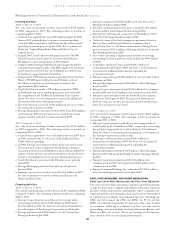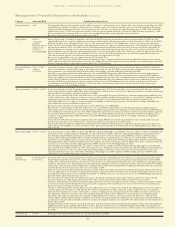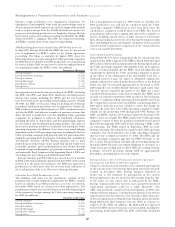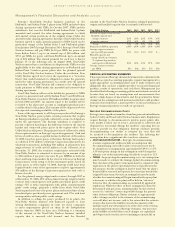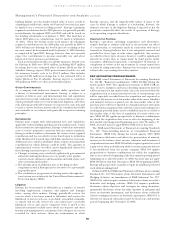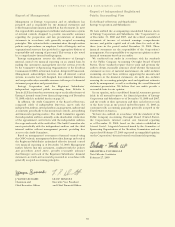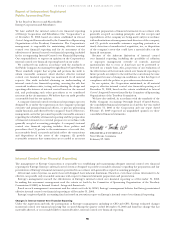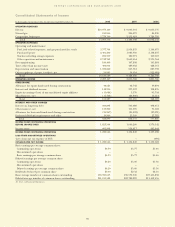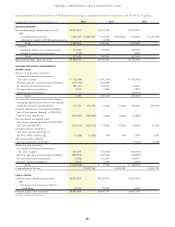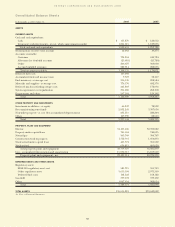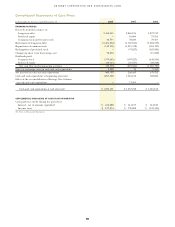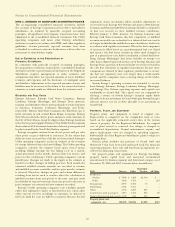Entergy 2008 Annual Report Download - page 54
Download and view the complete annual report
Please find page 54 of the 2008 Entergy annual report below. You can navigate through the pages in the report by either clicking on the pages listed below, or by using the keyword search tool below to find specific information within the annual report.
52
ENTERGY CORPORATION AND SUBSIDIARIES 2008
Management’s Financial Discussion and Analysis continued
52
Assumptions
Key actuarial assumptions utilized in determining these costs
include:
nDiscount rates used in determining the future benefit
obligations;
nProjected health care cost trend rates;
nExpected long-term rate of return on plan assets; and
nRate of increase in future compensation levels.
Entergy reviews these assumptions on an annual basis and adjusts
them as necessary. The falling interest rate environment and
worse-than-expected performance of the financial equity markets
in previous years have impacted Entergy’s funding and reported
costs for these benefits. In addition, these trends have caused
Entergy to make a number of adjustments to its assumptions.
In selecting an assumed discount rate to calculate benefit
obligations, Entergy reviews market yields on high-quality
corporate debt and matches these rates with Entergy’s projected
stream of benefit payments. Based on recent market trends,
Entergy increased its discount rate used to calculate benefit
obligations from 6.5% in 2007 to 6.75% for pension and 6.7% for
other postretirement benefits in 2008. Entergy’s assumed discount
rate used to calculate the 2006 benefit obligations was 6.00%.
Entergy reviews actual recent cost trends and projected future
trends in establishing health care cost trend rates. Based on this
review, Entergy’s health care cost trend rate assumption used in
calculating the December 31, 2008 accumulated postretirement
benefit obligation was an 8.5% increase in health care costs in
2009 gradually decreasing each successive year, until it reaches a
4.75% annual increase in health care costs in 2015 and beyond.
In determining its expected long-term rate of return on
plan assets, Entergy reviews past long-term performance, asset
allocations, and long-term inflation assumptions. Entergy targets
an asset allocation for its pension plan assets of roughly 65% equity
securities and 35% fixed-income securities. The target allocation
for Entergy’s other postretirement benefit assets is 51% equity
securities and 49% fixed-income securities. Entergy’s expected
long-term rate of return on pension plan and non-taxable other
postretirement assets used were 8.5% in 2008, 2007 and 2006.
Entergy’s expected long-term rate of return on taxable other
postretirement assets were 5.5% in 2008 and 2007 and 2006. The
assumed rate of increase in future compensation levels used to
calculate benefit obligations was 4.23% in 2008 and 2007 and
3.25% in 2006.
Cost Sensitivity
The following chart reflects the sensitivity of qualified pension
cost to changes in certain actuarial assumptions (dollars in
thousands):
Impact on
Qualified
Impact on 2008 Projected
Change in Qualified Benefit
Actuarial Assumption Assumption Pension Cost Obligation
Increase/(Decrease)
Discount rate (0.25%) $10,797 $111,953
Rate of return on plan assets (0.25%) $ 6,781 –
Rate of increase in compensation 0.25% $ 5,593 $ 29,424
The following chart reflects the sensitivity of postretirement
benefit cost to changes in certain actuarial assumptions (dollars
in thousands):
Impact on
Accumulated
Impact on 2008 Postretirement
Change in Postretirement Benefit
Actuarial Assumption Assumption Benefit Cost Obligation
Increase/(Decrease)
Health care cost trend 0.25% $6,151 $29,047
Discount rate (0.25%) $4,018 $33,496
Each fluctuation above assumes that the other components of the
calculation are held constant.
Accounting Mechanisms
In September 2006, Financial Accounting Standards Board (FASB)
issued SFAS 158, “Employer’s Accounting for Defined Benefit
Pension and Other Postretirement Plans, an amendment of FASB
Statements Nos. 87, 88, 106 and 132(R),” to be effective December
31, 2006. SFAS 158 requires an employer to recognize in its balance
sheet the funded status of its benefit plans. Refer to Note 11 to
the financial statements for a further discussion of SFAS 158 and
Entergy’s funded status.
In accordance with SFAS No. 87, “Employers’ Accounting for
Pensions,” Entergy utilizes a number of accounting mechanisms that
reduce the volatility of reported pension costs. Differences between
actuarial assumptions and actual plan results are deferred and are
amortized into expense only when the accumulated differences
exceed 10% of the greater of the projected benefit obligation or the
market-related value of plan assets. If necessary, the excess is amortized
over the average remaining service period of active employees.
Entergy calculates the expected return on pension and other
postretirement benefit plan assets by multiplying the long-term
expected rate of return on assets by the market-related value
(MRV) of plan assets. Entergy determines the MRV of pension
plan assets by calculating a value that uses a 20-quarter phase-in
of the difference between actual and expected returns. For other
postretirement benefit plan assets Entergy uses fair value when
determining MRV.
Costs and Funding
In 2008, Entergy’s total qualified pension cost was $98 million.
Entergy anticipates 2009 qualified pension cost to be $86
million. Pension funding was $287.8 million for 2008. Entergy’s
contributions to the pension trust are currently estimated to be
$140 million in 2009, although market conditions occurring in
2008 could have impacts to that expected amount, as further
described below. Guidance pursuant to the Pension Protection
Act of 2006 (Pension Protection Act) rules, effective for the 2008
plan year and beyond, continues to evolve, be interpreted through
technical corrections bills, and discussed within the industry and
congressional lawmakers. Any changes to the Pension Protection
Act as a result of these discussions and efforts may affect the level
of Entergy’s pension contributions in the future.
The Pension Protection Act of 2006 was signed by the President
on August 17, 2006. The intent of the legislation is to require
companies to fund 100% of their pension liability; and then for
companies to fund, on a going-forward basis, an amount generally
estimated to be the amount that the pension liability increases
each year due to an additional year of service by the employees
eligible for pension benefits.
The recent decline in stock market prices will affect Entergy’s
planned levels of contributions in the future. Minimum required
funding calculations as determined under Pension Protection Act
guidance are performed annually as of January 1 of each year and
are based on measurements of the market-related values of assets
and funding liabilities as measured at that date. An excess of the



